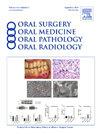Molar-incisor malformation: a case report
IF 2
3区 医学
Q2 DENTISTRY, ORAL SURGERY & MEDICINE
Oral Surgery Oral Medicine Oral Pathology Oral Radiology
Pub Date : 2025-02-04
DOI:10.1016/j.oooo.2024.11.030
引用次数: 0
Abstract
Clinical presentation
A 13-year-old male patient was referred to the pathology clinic at The University of Iowa, College of Dentistry to evaluate the first molars for root resorption. The patient has a reported history of Ehlers-Danlos syndrome. The clinical impression, upon examination was that of molar-incisor malformation (MIM). Radiographs were ordered to confirm the diagnosis. Radiographic evaluation of a cone beam computed tomography showed an altered morphology of the maxillary and mandibular right and left first molars wherein the teeth were smaller in size, had smaller and narrow pulp chambers, narrowed less defined canals, thinned enamel and noticeable cervical constriction. The radiographic findings were consistent with a diagnosis of MIM; however, the incisors have no significant morphologic variations in their development.
Differential Diagnosis
Dental anomalies have been reported in cases of Ehlers-Danlos syndrome; however, this particular appearance of the teeth has not been associated with the disorder previously. No other plausible conditions have this appearance localized to the first molars.
Diagnosis and Management
As the etiology of MIM is unclear and could be multifactorial, genetic, and histologic verification were not used in this case. Diagnosis was determined on the basis of medical history and clinical and radiographic examination. The patient had the permanent first molars extracted in spring of 2023 and is under orthodontic treatment to close the remaining spaces orthodontically.
Conclusion
Although MIM has been first described in the literature relatively recently, it is thought to involve epigenetic factors related to brain-related systemic diseases and root development. In this case study the only condition that was reported on was Ehlers-Danlos syndrome, and although there are some dental anomalies that can be contributed to the disorder, MIM does not appear to be one of them. This reflects how little is still known about the etiology of the condition and highlights the importance of continued research on the topic.
求助全文
约1分钟内获得全文
求助全文
来源期刊

Oral Surgery Oral Medicine Oral Pathology Oral Radiology
DENTISTRY, ORAL SURGERY & MEDICINE-
CiteScore
3.80
自引率
6.90%
发文量
1217
审稿时长
2-4 weeks
期刊介绍:
Oral Surgery, Oral Medicine, Oral Pathology and Oral Radiology is required reading for anyone in the fields of oral surgery, oral medicine, oral pathology, oral radiology or advanced general practice dentistry. It is the only major dental journal that provides a practical and complete overview of the medical and surgical techniques of dental practice in four areas. Topics covered include such current issues as dental implants, treatment of HIV-infected patients, and evaluation and treatment of TMJ disorders. The official publication for nine societies, the Journal is recommended for initial purchase in the Brandon Hill study, Selected List of Books and Journals for the Small Medical Library.
 求助内容:
求助内容: 应助结果提醒方式:
应助结果提醒方式:


